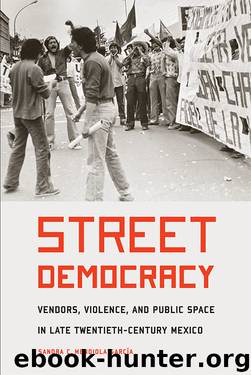Street Democracy by Sandra C. Mendiola García

Author:Sandra C. Mendiola García [Mendiola García, Sandra C.]
Language: eng
Format: epub
Tags: HIS025000 History / Latin America / Mexico
ISBN: 978-1-4962-0001-3
Publisher: University of Nebraska Press
Published: 2017-02-01T16:00:00+00:00
Fig. 11. La Victoria market classroom. Courtesy of Archivo General Municipal de Puebla, 1963.
La Victoria market was more than a commercial center. It also provided the growing working-class community with a number of services. In the 1910s it was one of the first buildings with electricity. It had a laboratory for water testing, and people could rent cheap apartments on the second floor.11 In the late 1940s the market provided beds, showers, and clothing for street children.12 Marketers listened to their own radio station, AXA-Audio Victoria.13 In the late 1950s there was a doctor’s office and a classroom where women could learn how to sew.14 In the 1960s the market housed a classroom where male children and teenagers learned basic reading and writing skills.15
La Victoria was instrumental in sustaining the livelihood of thousands of marketers and street vendors. Female marketers and street vendors performed reproductive labor while tending their business, feeding and watching after their children, teaching them the skills of the trade. The market became the second home for most market sellers and their families. Street vendors who traded outside the market used its public bathrooms, and some sent their children to its public day care center.16 The most modest street vendors who came from small and remote rural towns utilized the market as an overnight warehouse for their merchandise. Some used it as a place to sleep; market administrators constantly complained about street vendors who spent the night inside the market.17
Outside the market hundreds and eventually thousands of street vendors set up rudimentary, semi-fixed, and even fixed stalls to display fruit, vegetables, pots, meat, live animals, flowers, and seasonal products. They sold these in small quantities and at low prices to a mostly poor and working-class clientele.18 They set up their stalls on sidewalks, on street corners, outside stores, and sometimes right in the middle of the street. Although customers appreciated the street vendors’ affordable and varied merchandise, their presence bothered some sectors of Puebla’s society.
Download
This site does not store any files on its server. We only index and link to content provided by other sites. Please contact the content providers to delete copyright contents if any and email us, we'll remove relevant links or contents immediately.
| Arms Control | Diplomacy |
| Security | Trades & Tariffs |
| Treaties | African |
| Asian | Australian & Oceanian |
| Canadian | Caribbean & Latin American |
| European | Middle Eastern |
| Russian & Former Soviet Union |
The Secret History by Donna Tartt(18951)
The Social Justice Warrior Handbook by Lisa De Pasquale(12170)
Thirteen Reasons Why by Jay Asher(8849)
This Is How You Lose Her by Junot Diaz(6837)
Weapons of Math Destruction by Cathy O'Neil(6220)
Zero to One by Peter Thiel(5736)
Beartown by Fredrik Backman(5682)
The Myth of the Strong Leader by Archie Brown(5463)
The Fire Next Time by James Baldwin(5386)
How Democracies Die by Steven Levitsky & Daniel Ziblatt(5175)
Promise Me, Dad by Joe Biden(5117)
Stone's Rules by Roger Stone(5053)
A Higher Loyalty: Truth, Lies, and Leadership by James Comey(4909)
100 Deadly Skills by Clint Emerson(4882)
Rise and Kill First by Ronen Bergman(4741)
Secrecy World by Jake Bernstein(4703)
The David Icke Guide to the Global Conspiracy (and how to end it) by David Icke(4658)
The Farm by Tom Rob Smith(4468)
The Doomsday Machine by Daniel Ellsberg(4452)
